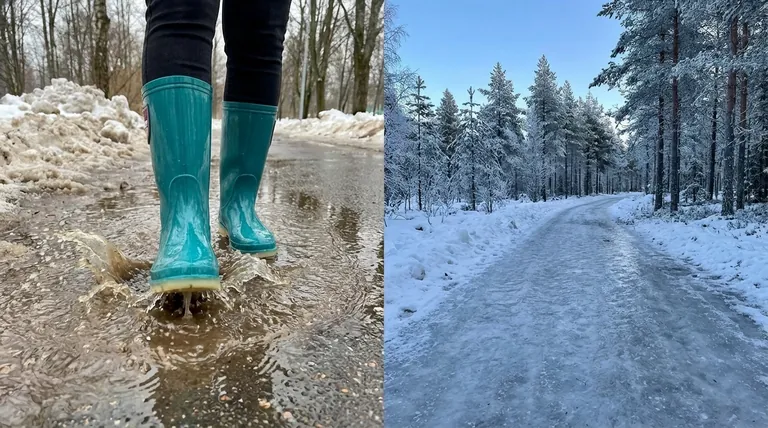To be clear, the effectiveness of rubber or slip-on boots in winter depends entirely on your definition of "winter." For wet, rainy, and slushy conditions above freezing, they are an excellent choice due to their superior waterproofing. However, for cold, snowy, and icy environments, their lack of insulation and poor traction make them an inadequate and potentially unsafe option.
The core issue is a trade-off between waterproofing and insulation. Rubber boots are designed to keep water out, not to keep warmth in. Their utility in winter is therefore limited to scenarios where staying dry is the primary challenge, not staying warm.

The Core Function: Waterproofing vs. Insulation
Understanding why a rubber boot succeeds in one winter scenario and fails in another comes down to the properties of the material itself.
Where Rubber Boots Excel: Unbeatable Waterproofing
The primary design of a rubber boot, like a classic Wellington, is to create a seamless, impenetrable barrier against moisture.
This makes them the ideal tool for navigating deep puddles, melting slush, and heavy rain. When the main goal is to keep your feet completely dry from external wetness, rubber is king.
The Critical Weakness: Poor Thermal Regulation
Rubber is a poor insulator. It readily conducts cold from the ground directly to your foot, offering little protection from freezing temperatures.
Unlike dedicated snow boots with foam or felt liners, rubber boots do not trap air to create a thermal barrier. This means any warmth your foot generates is quickly lost to the cold environment.
Understanding the Trade-offs
Relying on a rubber boot for true winter cold introduces several practical problems and potential risks.
The Myth of "Just Add Thick Socks"
While wearing thick wool or thermal socks can help, it is often a temporary and insufficient solution.
The socks can only slow down heat loss; they cannot stop the constant cold being conducted through the rubber sole and shell. In prolonged exposure to cold, your feet will eventually become cold regardless of the sock thickness.
The Hidden Danger: Lack of Traction
Most standard rubber boots have soles designed for traction in mud and water, not on ice or packed snow.
These soles typically lack the deep, multi-directional lugs and specialized rubber compounds found on dedicated snow boots. This creates a significant slipping hazard on icy surfaces.
The Problem with Perspiration
Rubber does not breathe. As your foot sweats, that moisture becomes trapped inside the boot.
This dampness dramatically accelerates heat loss, making your feet feel even colder and clammier—a dangerous combination in freezing temperatures.
Making the Right Choice for Your Winter
To select the right footwear, you must first define the conditions you will face.
- If your primary focus is a mild, wet winter: Rubber boots are an excellent and practical choice for keeping your feet dry from rain and slush.
- If your primary focus is a cold, snowy winter: You need a dedicated, insulated, and waterproof snow boot with a high-traction sole for warmth and safety.
- If you need a boot for short-term tasks in light snow: A rubber boot can suffice for brief periods, but only when paired with high-quality thermal socks, and you must remain aware of slippery surfaces.
Ultimately, choosing the right boot means matching the footwear's design to the demands of your environment.
Summary Table:
| Scenario | Rubber Boot Effectiveness | Key Reason |
|---|---|---|
| Wet, Slushy Conditions | Excellent | Superior waterproofing keeps feet dry. |
| Cold, Snowy/Icy Conditions | Poor/Unsafe | Lacks insulation and proper traction. |
Need the right boot for your climate? As a large-scale manufacturer, 3515 produces a comprehensive range of footwear for distributors, brand owners, and bulk clients. Whether you need reliable rubber boots for wet conditions or high-performance insulated boots for harsh winters, our production capabilities encompass all types of shoes and boots to meet your exact needs. Contact us today to discuss your requirements!
Visual Guide

Related Products
- Factory Direct Wholesale Rain Boots Durable Waterproof & Fully Customizable
- Premium Flame-Retardant Waterproof Safety Boots and Shoes
- Factory-Direct Wholesale Canvas Boots with High-Traction Rubber Soles
- Wholesale Safety Footwear Manufacturer for Bulk & Custom OEM Orders
- Wholesale Waterproof Tactical Boots Custom Suede & High-Traction Soles
People Also Ask
- What are the limitations of rain boots in certain climates? Find the Right Footwear for Your Weather
- What are the distinctive features of rain boots? Unmatched Waterproof Protection Explained
- What are the main materials used in the production of rain boots? A Guide to Durability & Comfort
- What are the characteristics of rubber as a rain boot material? Discover Its Durability & Flexibility
- What factors should be considered when choosing rain boots? Find the Perfect Boot for Your Needs



















